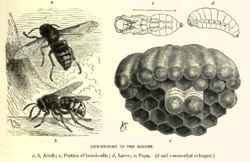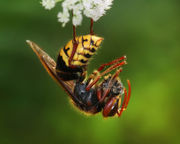Hornet
| Hornet | |
|---|---|
.jpg) |
|
| Oriental hornet, Vespa orientalis | |
| Scientific classification | |
| Kingdom: | Animalia |
| Phylum: | Arthropoda |
| Class: | Insecta |
| Order: | Hymenoptera |
| Suborder: | Apocrita |
| Family: | Vespidae |
| Subfamily: | Vespinae |
| Genus: | Vespa Linnaeus, 1758 |
| Species | |
|
See text |
|
Hornets are the largest eusocial wasps; some species can reach up to 5.5 cm (2.2 in) in length. The true hornets make up the genus Vespa and are distinguished from other vespines by the width of the vertex (part of the head behind the eyes), which is proportionally larger in Vespa and by the anteriorly rounded gasters (the section of the abdomen behind the wasp waist).
Contents |
Life cycle

In Vespa crabro, the nest is founded in spring by a fertilized female known as the queen. It generally selects sheltered places like dark hollow tree trunks. It first builds a series of cells (up to 50) out of chewed tree bark. The cells are arranged in horizontal layers named combs, each cell being vertical and closed at the top. An egg is then laid in each cell. After 5–8 days, the egg hatches, and in the next two weeks, the larva undergoes its five stages. During this time, the queen feeds in a protein-rich diet of insects. Then, the larva spins a silk cap over the cell's opening and, during the next two weeks, transforms into an adult, a process called metamorphosis. Then, the adult eats its way through the silk cap. This first generation of workers, invariably females, will now gradually undertake all the tasks that were formerly carried out by the queen (foraging, nest building, taking care of the brood, etc.) with one exception: egg-laying, which remains exclusive to the queen.

As the colony size grows, new combs are added, and an envelope is built around the cell layers until the nest is entirely covered with the exception of an entry hole. At the peak of its population, the colony can reach a size of 700 workers, which occurs in late summer.
At this time, the queen starts producing the first reproductive individuals. Fertilized eggs develop into females (called "gynes" by entomologists), and unfertilized ones develop into males (sometimes called "drones"). Adult males do not participate in nest maintenance, foraging, or caretaking of the larvae. In early to mid-autumn, they leave the nest and mate during "nuptial flights". Males die shortly after mating. The workers and queens survive at most until mid to late autumn; only the fertilized queens survive over winter.
Other temperate species (e.g. the Yellow hornet, V. simillima, or the Oriental hornet, V. orientalis) have similar cycles. In the case of tropical species (e.g., V. tropica), life histories may well differ, and in species with both tropical and temperate distributions (such as the Asian giant hornet, Vespa mandarinia), it is conceivable that the cycle depends on latitude.
Stings
A hornet's sting is painful to humans, but the sting toxicity varies greatly by hornet species. Some deliver just a typical insect sting, while others are among the most venomous known insects.[1] Allergic reactions, fatal in severe cases, can occur; an individual suffering from anaphylactic shock may die unless treated immediately via epinephrine ("adrenaline") injection using a device such as an EpiPen, with prompt followup treatment in a hospital.
- European hornet sting
- in itself is not fatal except sometimes to allergic victims.[1]
- Non-European hornet sting
- in itself is not fatal except sometimes to allergic victims.[1]
- multiple stings (an entire nest) can be fatal due to highly toxic species-specific additions in the venom.[2]
- is more toxic than a wasp and bee sting combined
- from the Asian giant hornet (Vespa mandarinia japonica) is the most venomous known (per sting).[1]
- All hornet stings
- are an allergen for people with an allergy to wasp venom.
- those allergic to wasp venom are not necessarily allergic to bee venom as they contain different chemicals.
- are more painful than a typical wasp's due to a large amount (5%) of acetylcholine.[3] See Schmidt Sting Pain Index.[4]
As in all stinging wasps, hornets can sting multiple times; they do not die after stinging a human as is typical for a worker honey bee, as a hornet's sting is not barbed (the honey bee stinger has evolved for defending the nest against vertebrates/mammals). They can also bite and sting at the same time.
Alarm escalation
Hornets, like many social wasps, can mobilize the entire nest to sting in defense, which is highly dangerous to humans. The hornet alarm pheromone is used to raise alarm of nest attack and to identify prey, such as bees.[5] It is not advisable to kill a hornet anywhere near a nest, as the distress signal can trigger the entire nest to attack. Materials that come in contact with pheromone, such as clothes, skin, dead prey, or hornets, must be removed from the vicinity of the hornets nest. Perfumes and other volatile chemicals can be falsely identified as pheromone by the hornets and trigger an attack.
Prey
Hornets prey on many insects that are considered to be pests. They do also prey on bees, but unlike honey bees, hornet colonies die out every winter.
Hornets and other Vespidae

While taxonomically well-defined, there may be some ambiguity about the differences between hornets and other wasps of the family Vespidae, specifically the yellow jackets, which are members of the same subfamily. Yellow jackets are generally smaller than hornets and are bright yellow and black, whereas hornets may be darker in color - see wasp and bee characteristics.
Another major difference between yellow jackets and hornets is each of their food choices and aggression towards humans. In autumn, yellow jackets may be attracted to human foods and food wastes, increasing potentially aggressive contact between yellow jackets and humans. Hornets, on the other hand, tend to stick to live insects.
Some other large wasps are sometimes referred to as hornets, most notably the bald-faced hornet (Dolichovespula maculata) found in North America. It is set apart by its black and ivory coloration. The name "hornet" is used for this and related species primarily because of their habit of making aerial nests (similar to the true hornets) rather than subterranean nests. Another example is the Australian hornet (Abispa ephippium), which is actually a species of potter wasp.
Species
- Vespa affinis
- Vespa analis
- Vespa auraria
- Vespa basalis
- Vespa bellicosa
- Vespa bicincta
- Vespa bicolor
- Vespa binghami
- Vespa crabro
- Vespa ducalis
- Vespa dybowskii
- Vespa fervida
- Vespa fumida
- Vespa luctuosa
- Vespa mandarinia
- Vespa mocsaryana
- Vespa multimaculata
- Vespa orientalis
- Vespa philippinensis
- Vespa simillima
- Vespa soror
- Vespa tropica
- Vespa velutina
- Vespa vivax
Notable species
- Asian giant hornet Vespa mandarinia
- Vespa mandarinia japonica (sometimes known as Japanese giant hornet) - the largest wasp, and the most venomous known insect (per sting).[1]
- Black-bellied hornet Vespa basalis
- European hornet Vespa crabro, (sometimes known as Old World Hornet, or Brown Hornet).
- Greater banded hornet Vespa tropica
- Japanese hornet Vespa simillima (sometimes known as Japanese yellow hornet).
- Lesser banded hornet Vespa affinis
- Oriental hornet Vespa orientalis
- Yellow-legged hornet Vespa velutina
- Vespa luctuosa the most lethal wasp venom (per volume).[1]
See also
- Australian hornet
- Bald-faced hornet
- Bee-eater
- Characteristics of common wasps and bees
- German wasp
- Hymenoepimecis argyraphaga
- Median wasp
- Mud dauber
- Paper wasp
- Pepsis wasp / tarantula hawk
- Pollen wasp
- Potter wasp
- Vespid
- Yellowjacket
Notes
- ↑ 1.0 1.1 1.2 1.3 1.4 1.5 J.O. Schmidt, S. Yamane, M. Matsuura, C.K. Starr (1986). "Hornet venoms: lethalities and lethal capacities.". Toxicon 24 (9): 950–4. doi:10.1016/0041-0101(86)90096-6. PMID 3810666.
- ↑ P. Barss (1989). "Renal failure and death after multiple stings in Papua New Guinea. Ecology, prevention and management of attacks by vespid wasps". Med J Aust. 151 (11-12): 659–63. PMID 2593913.
- ↑ K. D. Bhoola, J. D. Calle, and M. Schachter (1961). "Identification of acetylcholine, 5-hydroxytryptamine, histamine, and a new kinin in hornet venom (V. crabro)". J Physiol. 159 (1): 167–182.
- ↑ "Stung – How tiny little insects get us to do exactly as they wish". http://discovermagazine.com/2003/jun/featstung/.
- ↑ "Volatile fragrance chemicals may attract unwanted attention from hornets and bees". http://pubs.acs.org/cen/critter/8137hornets.html.
External links
- European hornet protection site (English) (also available in French, German, Russian, Spanish and Swedish)
- Differences between Yellowjackets and HornetsPDF (218 KiB)
- Paper Wasps and Hornets
- Hornetboy's homepage
- Controlling Wasps, Hornets, and Yellowjackets
- Hornets & Yellowjackets
- Yellowjackets and Other Social Wasps
- Vespidae of the World
- yellowjackets and hornets of Florida on the UF / IFAS Featured Creatures Web site